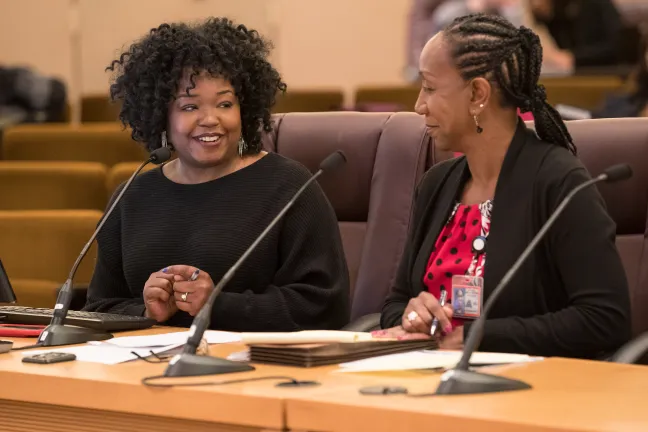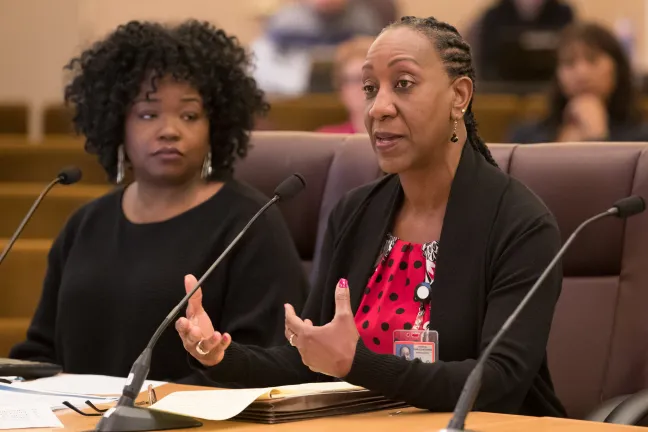Under the new leadership of Health Department Director Patricia Charles-Heathers, Ph.D., and Mental Health and Addiction Services Division Director Ebony Clarke, Multnomah County is re-envisioning how it delivers mental health and addiction services, the directors told the Board of Commissioners Tuesday during a briefing on mental health services for adults.
The Department is looking to integrate behavioral health services into physical health clinics, examining ways to work with other departments and health programs that also provide behavioral health services, and considering renaming its Division from the Mental Health and Addiction Services Division to the Behavioral Health Division.
“It’s about recognizing we treat the whole person, and when people come into treatment, they come with everything else that is happening in their lives,” Charles-Heathers said Tuesday. “We want to be able to integrate our services so we see everything that person brings with them.”
In the Board’s second briefing on its role as the Local Mental Health Authority, Charles-Heathers and Clarke provided an overview of the adult care system, identified gaps in that system and proposed changes to improve services.
The Mental Health and Addiction Services Division serves the county’s 173,000 residents enrolled in Medicaid — about 13 percent of those residents seek behavioral health services — as well as anyone who is under-insured or uninsured. Each year, the system serves nearly 50,000 people, about 3 percent of whom live with serious and persistent mental illness. These are the people with the highest needs, people who might experience multiple hospitalizations, who might need medication, continued therapy, and supportive housing, and who too often fall through the gaps.
“When we talk about serious and persistent mental illness, we have to recognize our goal is to provide hope and recognize some of these symptoms may never go away,” said Charles-Heathers. “That’s why a continuum of care is so important. People may have different needs at different times.”
The Continuum of Care
Adults living with chronic and severe mental illness might experience the full continuum of Oregon’s mental health system.
The most intensive care is provided in the Oregon State Hospital. Locally, shorter-term psychiatric care is provided through local hospital systems, such as the Unity Center for Behavioral Health, or at the Multnomah County Crisis Assessment and Treatment Center.
People in immediate crisis connect to services a number of ways: by calling the Multnomah County Mental Health Call Center, visiting the Urgent Walk-In Clinic, or by connecting with a crisis response clinician. Families caring for people with severe mental illness also seek respite care.
Some people require residential treatment, which ranges from secure facilities to adult care homes, while others may get what they need through outpatient treatment or intensive case management, such as Cascadia Behavioral Health’s Assertive Community Treatment and Forensic Assertive Community Treatment.
Most clients who seek mental health and addiction services through Multnomah County never need such intensive treatment, Clarke told the Board. That’s where general outpatient services such as counseling and addiction peer support come in.
The Division also offers preventative services including training such as Mental Health First Aid to help the public understand and respond to people in crisis, and workshops to help residents identify suicide risks and intervene in a safe manner.
Commissioner Sharon Meieran, who led an in-depth review of the regional mental health system, said more emphasis should be placed on prevention. “A lot of times prevention gets skipped over,” Meieran said. “I think there’s an overlap with public health and … it seems like a great opportunity for synergy there. A peer resource center seems like it could play a role in a preventative sense.”
Opportunities for Change
Gaps are glaring across the spectrum, Clarke acknowledged Tuesday. “A lot of our issues have to do with not having enough capacity,” she said, laying out some of the most urgent needs.
The system lacks adequate inpatient treatment and accessible housing for patients with chronic mental illness and respite options for caregivers.
The workforce is aging into retirement, and fewer people are interested in entering the field. That’s because the work is taxing and the wages are relatively low. Substance use disorder providers often make less than other professionals with similar educational backgrounds, even within the behavioral health field.
The County supports only a single mental health urgent walk-in center and has relatively few culturally-specific services even as the population expands and the needs change.
Charles-Heathers said the Health Department has begun examining ways to streamline the mental health and addiction services offered across Health programs and County departments and integrate complementary services.
That could include co-locating physical and behavioral healthcare and providing satellite locations for urgent walk-in care at primary care clinics. Closer coordination may also allow clients to step down more easily from high levels of care.
“When people are stabilized, when things are going well and they have a support system, and then after two or three years, we can move them out of mental health so they can get that service through primary care physicians,” Charles-Heathers said.
Commissioners voiced broad support for streamlining and coordinating services within the Health Department, with other Departments and regionally.
“When I think of healthcare the direction we have to be going is making not such a difference between mental health and physical health,” said Commissioner Jessica Vega Pederson.
“We have done a lot of work with our partners in other counties,” said Chair Deborah Kafoury. “Then there’s so much opportunity with the CCO 2.0 conversation, where all the partners recognize the need for more capacity and access.”

